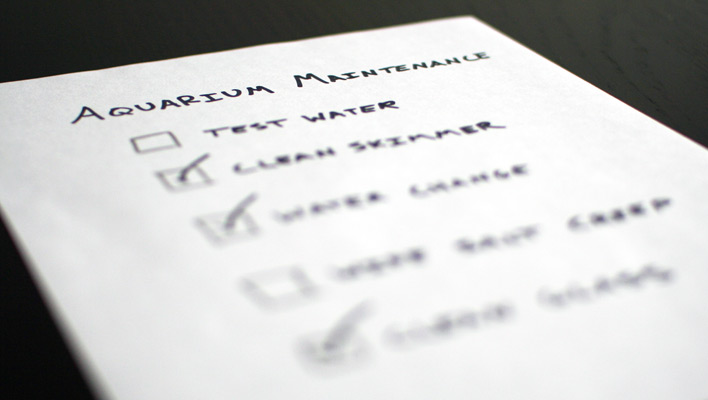There’s no question that a saltwater aquarium requires a significant amount of maintenance if the fish and invertebrates it contains are to remain healthy and their life-support system is to continue functioning efficiently for the long term. But that doesn’t mean you should let all those routine chores overwhelm you! Ongoing upkeep becomes much more tolerable when it’s broken up into manageable chunks.
The following schedule will help you better organize your time and effort while tackling routine maintenance responsibilities. We think you’ll find it’s a good starting point that you can easily adjust over time to suit your needs and the unique demands of your aquarium system.
Every day:
- Feed livestock (as appropriate for the species kept).
- Closely observe your specimens to ensure they’re all alive, healthy, uninjured, and interacting peacefully.
- Top off the tank/sump with purified fresh water to compensate for evaporation.
- Check the water temperature.
- Verify that all equipment is functioning properly.
- Check the tank and all hose, tube, or pipe connections for evidence of drips or leaks.
- Empty your protein skimmer collection cup. (Depending on skimmate production, the size of the cup, and whether or not the cup is equipped with a drain hose for remote skimmate collection, this could stretch to a weekly task.)
- Clean the algae film from your aquarium glass with an algae magnet, brush, or scraper. (Depending on the rate at which algae builds up on glass, this may be every other day or weekly.)
Weekly to biweekly:
- Test critical water parameters—specific gravity, pH, ammonia, nitrite, nitrate, and alkalinity. (Reefkeepers will also need to test calcium and possibly other parameters.)
- Wipe salt creep off the aquarium cover, tank edges, power cords, and other surfaces exposed to salt spray.
- Wipe clean the inside neck of your protein skimmer to eliminate gunk buildup and promote proper foam production.
- Thoroughly rinse any filter socks, foam blocks, sponge sleeves, bonded filter pads, or other mechanical filtration media to eliminate trapped particulate waste.
- Clean the algae film from your aquarium glass with an algae magnet, brush, or scraper.
- Perform at least a 10% water change weekly or a 20% change biweekly. Go larger if the nitrate level dictates!
Monthly to bimonthly:
- Clean calcium deposits from your tank cover and your light fixture cover glass (while the fixture is turned off and cool) using a cloth or paper towel dampened with white vinegar.
- Replace any activated carbon used in the system (monthly).
- Disassemble your protein skimmer and thoroughly clean all components.
- Soak powerheads, pumps, heaters, thermometers, and other removable submerged components in white vinegar or a 1:1 vinegar/water solution to dissolve coralline algae buildup.
Every six months to yearly:
- Replace the bulbs/tubes in your lighting fixture according to the manufacturer’s recommendations (except LEDs, which have a much longer functional life).
Again, this is just a sample schedule, and it’s certainly not “etched in stone.” As your experience and comfort level in the hobby increase, you’ll no doubt develop your own way of doing things and your own time frame for tackling routine maintenance chores.
As always, we’d love to hear from you in the comments section below if you have a unique take on routine maintenance that might benefit your fellow salties!




I have some powerheads that I haven’t seen for 25 years or so. They may be due for that soaking think you spoke of. But they are someplace behind the rocks and it would be difficult to find them unless I followed the cord. The pump running my skimmer is even older as it came in a wooden box wrapped in parchment paper with directions that read to keep in a cool bilge away from grog. I Think it was made by the Christopher Columbus pump company.
Every ten years I stir my substrate, which is dolomite and suck out any detritus, and every twenty years I look under my under gravel filter plates just to see what is growing under there and I sometimes host a party for my fish that are over 20 years old. Then every 30 years I build a new light fixture because they go out of style and every 40 years I sit back and say, Dam, that tank looks good. And so do I. I can’t wait to see what happens in the next 40 years.
Pretty cool, good stuff.
Once your tank is well established testing for nitrites is redundant and often unnecessary if your ammonia is zero. In fact I seldom test for at either
Good input, Bill! Water testing is definitely one of the aspects of this schedule that can be adjusted as the hobbyist’s comfort level increases and things become a bit more predictable. I like to think of it as discovering the “art” behind the science of aquarium keeping.
i agree checking for nitrites becomes redundant i have had my tank for 5 years and hardly ever check for nitrites ,well established tanks should never crash unless a drastic change is done within the tank…
If I’m being perfectly honest, I’d have to admit I go through a lot more nitrate test kits than either ammonia or nitrite (unless I’m cycling a new tank, of course).
Great list, well organized. Do you have a sense for how much you can extend the life of your pumps by soaking them monthly/bimonthly?
Thanks for your kind words, Al! I haven’t conducted any scientific comparisons between pumps that are soaked monthly or bimonthly and those that aren’t, so I can’t say with confidence how long this form/frequency of cleaning might extend their functional lifespan, but I’ve generally been very happy with the service life of my pumps and powerheads and all are cleaned in this manner.